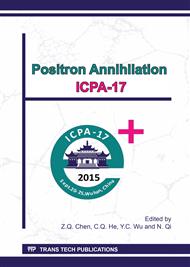[1]
Bell, Lon E, Cooling, heating, generating power, and recovering waste heat with thermoelectric systems, Science 321 (2008) 1457-1461.
DOI: 10.1126/science.1158899
Google Scholar
[2]
Snyder, G. J. & Toberer, Eric S. Toberer, Complex thermoelectric materials, Nature materials 7 (2008) 105-114.
DOI: 10.1038/nmat2090
Google Scholar
[3]
Tritt T M, Subramanian M A., Thermoelectric materials, phenomena, and applications: a bird's eye view, MRS bulletin 31 (2006) 188-198.
DOI: 10.1557/mrs2006.44
Google Scholar
[4]
Yang J, Caillat T, Thermoelectric materials for space and automotive power generation, MRS bulletin 31 (2006) 224-229.
DOI: 10.1557/mrs2006.49
Google Scholar
[5]
Sales, B. C., Mandrus, D. & Williams, R. K., Filled skutterudite antimonides: a new class of thermoelectric materials, Science 272 (1996) 1325-1328.
DOI: 10.1126/science.272.5266.1325
Google Scholar
[6]
Christensen, Mogens, et al, Avoided crossing of rattler modes in thermoelectric materials, Nature materials 7 (2008) 811-815.
DOI: 10.1038/nmat2273
Google Scholar
[7]
Poudel B, Hao Q, Ma Y, et al, High-thermoelectric performance of nanostructured bismuth antimony telluride bulk alloys, Science 320 (2008) 634-638.
DOI: 10.1126/science.1156446
Google Scholar
[8]
Liu H, Shi X, Xu F, et al, Copper ion liquid-like thermoelectric, Nature materials 11 (2012) 422-425.
Google Scholar
[9]
R. Krause-Rehberg and H. S. Leipner, Positron Annihilation in Semiconductors: Defect Studies, Springer, Berlin, 1999, pp.5-48.
DOI: 10.1007/978-3-662-03893-2_8
Google Scholar
[10]
Coleman P G. Positron beams and their applications, World Scientific, (2000).
Google Scholar
[11]
Sanyal D, Banerjee D, De U., Probing (Bi0. 92Pb0. 17)2Sr1. 91Ca2. 03Cu3. 06O10+δ superconductors from 30 to 300 K by positron-lifetime measurements, Physical Review B 58 (1998) 15226.
Google Scholar
[12]
Chakraverty S, Mitra S, Mandal K, et al. Positron annihilation studies of some anomalous features of NiFe2O4 nanocrystals grown in SiO2, Physical Review B 71 (2005) 024115.
Google Scholar
[13]
Dutta S, Chattopadhyay S, Jana D, et al. Annealing effect on nano-ZnO powder studied from positron lifetime and optical absorption spectroscopy, Journal of applied physics 100 (2006) 114328.
DOI: 10.1063/1.2401311
Google Scholar
[14]
Nieminen R M, Manninen M J., Positrons in imperfect solids: theory, Springer, Berlin Heidelberg, (1979).
Google Scholar


